Easy Charcuterie Board – The Best Guide You Need
Estimated reading time: 20 minutes
Table of contents
- Charcuterie Board Basics
- Charcuterie Board Origins
- What Are Charcuterie Boards Used For?
- How Do You Pronouce Charcuterie Board?
- What Should Be On A Basic Charcuterie Board?
- How To Make A Cheap And Easy Charcuterie Board For Beginners?
- Soft Vs. Hard Cheese — How To Choose For Your Easy Charcuterie Board
- Step 4: Arrange Your Easy Charcuterie Board
- The Ultimate Easy Charcuterie Board Pairings List
- How Do You Arrange An Easy Charcuterie Board?
- Tips For Making An Easy Charcuterie Board?
- Easy Charcuterie Board Themes
- Tips To Make Your Easy Charcuterie Board More Affordable
- What is The 3-3-3-3 Rule for Charcuterie Boards?
This is the ultimate guide to easy charcuterie boards. From tips to ideas use this guide to create a stunning and tasty charcuterie board!
This post may contain affiliate links, which means I’ll receive a commission if you purchase through my link, at no extra cost to you. Please read full disclosure here.
As an Amazon Affiliate I earn from qualifying purchases.
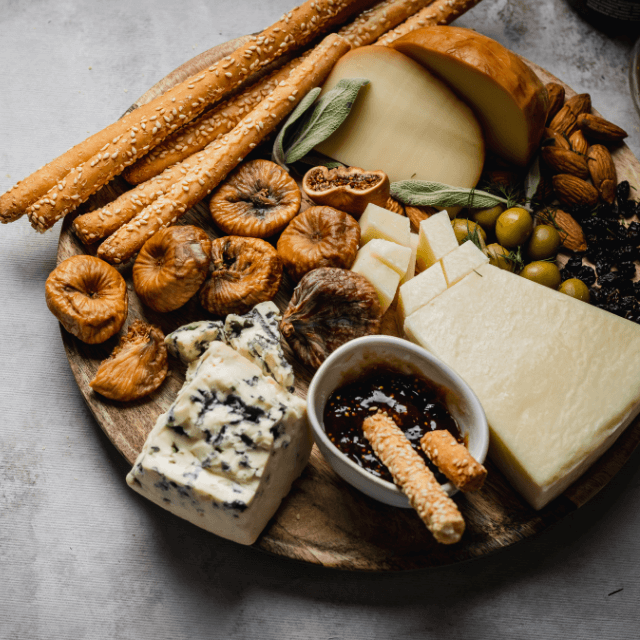
Are you looking for easy and quick charcuterie board ideas?
Whether you’re planning a gathering or simply want to enjoy a delicious and visually appealing snack, charcuterie boards are the perfect option.
In this post, we’ll provide you with a variety of easy charcuterie board ideas that are both affordable and quick to assemble.
From selecting the right cheeses and cured meats to choosing the perfect accompaniments and arranging them beautifully, we’ll guide you through the process of creating a stunning and tasty charcuterie board.
Get ready to impress your guests or indulge in a delightful treat for yourself with these ideas!
Charcuterie Board Basics
What Are Charcuterie Boards?
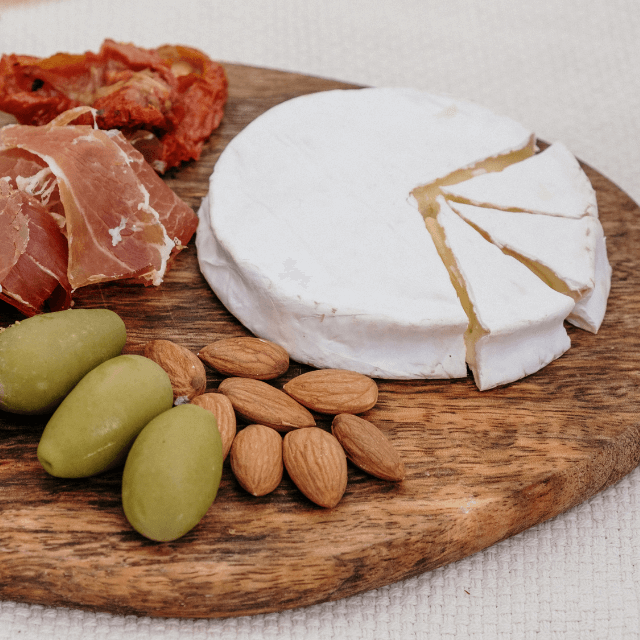
Charcuterie boards, also known as charcuterie platters or grazing boards, have a long history. They were traditionally used as a way to showcase and serve a variety of cured meats and other delicacies. These boards typically include an assortment of meats, cheeses, breads, fruits, nuts, and condiments, offering a delightful combination of flavors, textures, and colors.
Beautiful To Display Too!
Charcuterie Board Origins
Charcuterie is a culinary practice that originated in France, dating back to ancient times.
It involves the preparation, preservation, and presentation of various cured meats, sausages, pâtés, terrines, and other meat products.
The word “charcuterie” itself comes from the French words … “chair” (flesh) and “cuit” (cooked).
What Are Charcuterie Boards Used For?
In recent years, charcuterie boards have gained popularity beyond their French origins and have become a staple at parties, gatherings, and even casual get-togethers. They are loved for their versatility, as they can be customized to suit various tastes and dietary preferences. From elegant charcuterie spreads at upscale events to simple and casual DIY boards at home, charcuterie boards have become a favorite choice for food enthusiasts of all kinds.
Whether you’re planning a fancy soirée or a cozy night in, an easy charcuterie board is a great option to impress your guests or indulge in a delicious and visually appealing snack experience.
How Do You Pronouce Charcuterie Board?
There are (2) ways to pronounce charcuterie.
There are 4 syllables. charcuterie.
Char-cu-ter-ie
The only difference is the way a portion of the words is said.
🇫🇷 The French Pronunciation
🇫🇷 The French pronounce it like “Char-Cut-er-ie” where the cut sounds like “cuit” … not cut or coot.
🇬🇧 / 🇺🇸 The English / American Pronunciation
it is like Char-cu-ter-ie where the cu sounds like “coo”.
If you need help with your pronunciation I recommend this video:
What Should Be On A Basic Charcuterie Board?
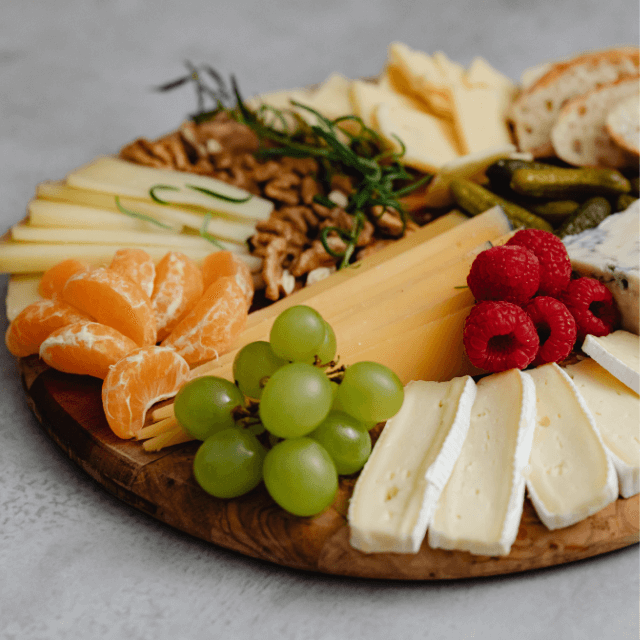
A basic charcuterie board typically includes:
- Cured meats such as prosciutto
- Cheeses such as cheddar
- Grains such as bread and crackers
- Fruits or sometimes vegetables
- Dried fruits like raisins
- Condiments such as mustard
- Preserves like a fig jam
- Nuts like walnuts
- Decorative greenery such as a sprig of rosemary
How To Make A Cheap And Easy Charcuterie Board For Beginners?
Here are the steps to create a cheap charcuterie board for beginners!
Be cautious of allergies! These recommendations should always be based on your diet and preferences. If you have concerns about foods and food pairings please consult your doctor before eating.
Step 1: Choose Your Cheeses
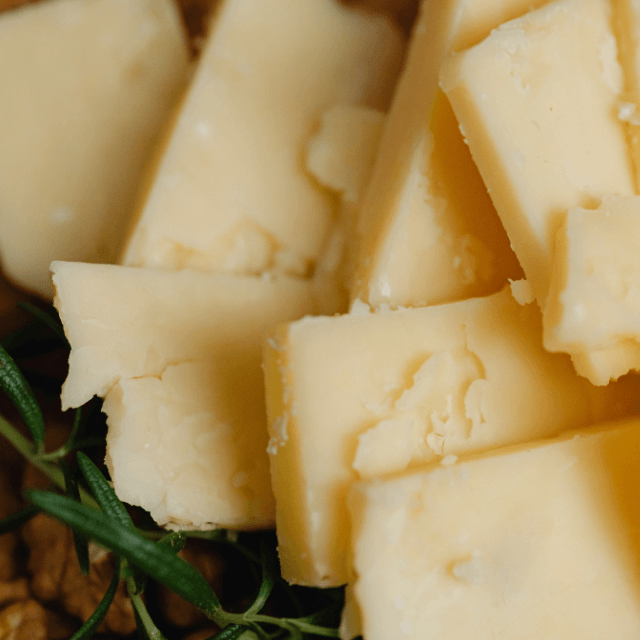
Tip: For affordability stick with economical cheeses, like cheddar or mozzarella, and stick with cheeses that have multiple pairings instead of just a few so you can mix and match! (see pairing chart below)
Popular Cheeses For Charcuterie Boards
Here are some delicious cheeses to consider for your charcuterie board:
Soft Cheeses
- Brie: A creamy and mild French cheese with a soft and velvety texture. It has a delicate and buttery flavor with hints of earthiness.
- Pairs well with sweetness such as fruit jams or candied nuts.
- Mozzarella: An Italian cheese known for its stretchy texture. It has a mild and milky flavor with a fresh and slightly salty taste.
- Gouda: A Dutch cheese with a smooth and creamy texture. It has a slightly sweet and nutty flavor with subtle caramel notes.
- Blue Cheese: A pungent cheese with a crumbly and creamy texture. It has a strong and tangy flavor with distinct veining and earthy undertones.
- Camembert: A soft and creamy French cheese with a bloomy rind. It has a rich and buttery flavor with a hint of mushroom.
- Feta: A brined cheese originating from Greece. It has a crumbly and slightly grainy texture with a tangy and salty taste.
- Goat Cheese (Chèvre): A cheese made from goat’s milk with a creamy and spreadable texture. It has a distinct and slightly tart flavor.
- Gorgonzola: An Italian blue cheese with a creamy and crumbly texture. It has a bold and tangy flavor with a hint of sweetness.
- Havarti: A Danish cheese with a semisoft and creamy texture. It has a buttery and slightly sweet flavor with a tangy undertone
Hard Cheeses
- Cheddar: A firm and sharp cheese originating from England. It has a rich and tangy flavor with a slightly crumbly texture.
- Manchego: A Spanish cheese made from sheep’s milk. It has a firm and crumbly texture with a rich and nutty flavor.
- Parmesan: An Italian cheese with a hard and granular texture. It has a strong and savory flavor with a salty and nutty taste.
Feel free to mix and match these cheeses based on your preferences and the flavors you want to offer on your charcuterie board. Enjoy!
Soft Vs. Hard Cheese — How To Choose For Your Easy Charcuterie Board
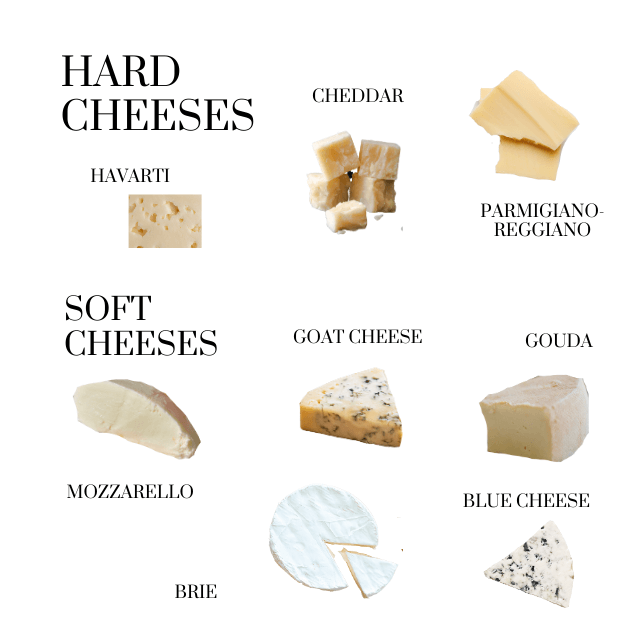
These terms refer to the texture and aging process of the cheese.
The aging process and moisture content play a significant role in determining the texture and flavor of the cheese.
What Are Hard Cheeses?
Hard cheeses are aged for a longer time, which allows them to develop complex flavors and a denser texture.
Hard cheeses, also known as firm cheeses, are aged for a longer period compared to soft cheeses. They have a firm and dense texture, which allows them to be easily grated or sliced.
- Hard cheeses tend to have a more pronounced and intense flavor due to the aging process.
- They can range from mild and nutty to sharp and pungent. Hard cheeses are often used for grating, melting, or enjoying on their own.
- Some examples of hard cheeses include Parmesan, Cheddar, and Gouda.
What Are Soft Cheeses?
Soft cheeses are typically consumed shortly after production, resulting in a fresher and creamier texture.
Soft cheeses, also known as fresh cheeses, are typically young and have a high moisture content. They have a creamy and spreadable texture, making them perfect for spreading on bread or crackers.
- Soft cheeses have a milder and more delicate flavor compared to hard cheeses.
- They can range from mild and buttery to tangy and slightly acidic. Soft cheeses are known for their creamy and luscious texture, which pairs well with fruits, nuts, and other accompaniments.
- Examples of soft cheeses include Brie, Camembert, and Goat Cheese (Chèvre).
Both hard and soft cheeses offer a wide range of flavors and can be enjoyed in various ways. Whether you prefer the sharp and robust taste of hard cheese or the creamy and smooth texture of soft cheese, there is a cheese out there to suit every palate.
Step 2: Add Your Cured Meat Pairings
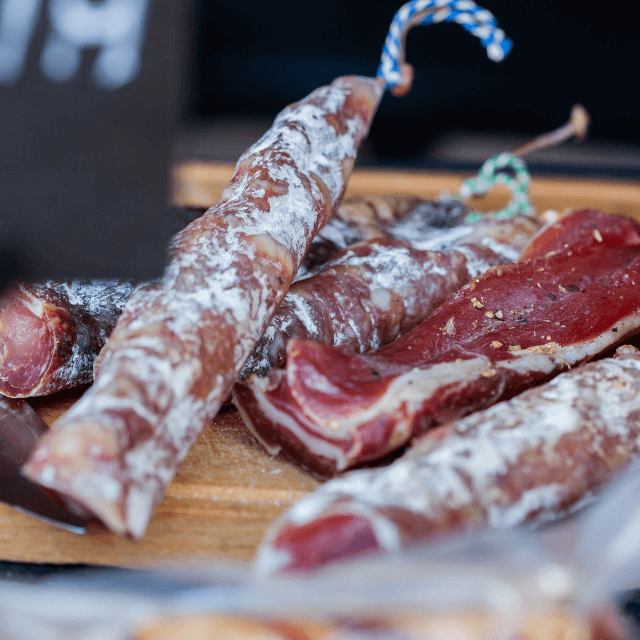
Tip: To make it more affordable stick with more affordable meats such as salami or pepperoni and pair well with as many cheeses as possible. (see pairing chart below)
Popular Cured Meat For Charcuterie Boards
- Prosciutto: A delicate and savory Italian cured ham with a buttery texture and a slightly sweet flavor.
- Salami: A seasoned and cured sausage with a rich and robust flavor, often featuring garlic, black pepper, and other spices.
- Pepperoni: A spicy and tangy Italian-American cured sausage, typically made with pork and flavored with paprika, chili peppers, and garlic.
- Soppressata: A rustic and flavorful Italian dry-cured salami, usually made with coarsely ground pork and seasoned with spices like fennel and black pepper.
- Chorizo: A smoky and spicy Spanish sausage made from pork and seasoned with paprika, garlic, and various spices.
- Coppa: A dry-cured Italian pork shoulder, seasoned with herbs and spices, and known for its rich, fatty flavor and tender texture.
- Pancetta: An Italian bacon made from pork belly, cured with salt and spices, and often used to add a salty and savory flavor to dishes.
- Bresaola: An air-dried and aged Italian beef, typically seasoned with herbs and spices, resulting in a tender and flavorful cured meat.
- Mortadella: A smooth and delicate Italian sausage made from finely ground pork, flavored with spices, and often studded with pistachios or olives.
- Ham: A cured pork leg, usually smoked or roasted, with a savory and slightly salty flavor.
Please note that some cheeses may not have specific pairings listed as they can be enjoyed on their own or combined with a variety of flavors. Feel free to get creative and experiment with different combinations based on your preferences.
Step 3: Opt for Inexpensive Bread or Crackers for the Starch Component.
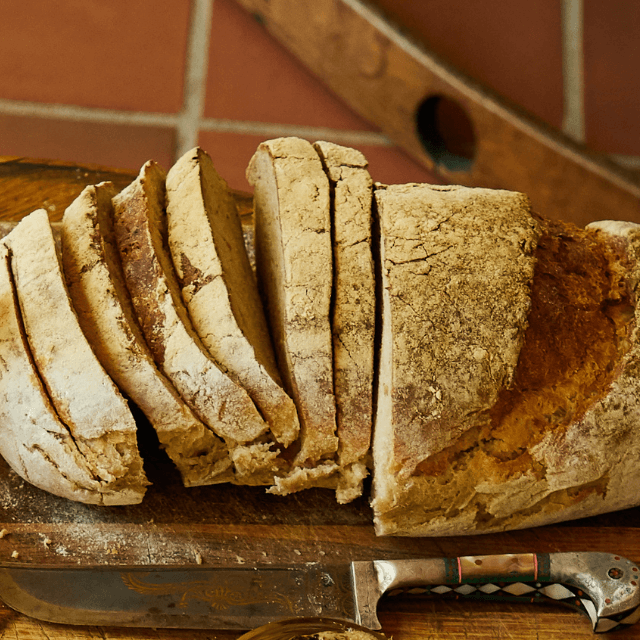
Here are some breads, crackers, and other starches that you can add to your charcuterie board:
(see pairing chart below)
Popular Bread Or Crackers For Your Easy Charcuterie Board
Crackers
- Water crackers: Plain, crisp, and thin crackers made with flour, water, and salt. They provide a neutral base for showcasing the flavors of the charcuterie.
- Crisps: Thin and crunchy snacks that come in various flavors, such as potato chips or vegetable crisps. They add a satisfying crunch to the charcuterie board.
- Whole grain crackers: Crackers are made with whole grain flour, which provide a heartier and more nutritious option compared to plain crackers.
- Pretzels: A baked snack made from dough twisted into a knot shape and sprinkled with coarse salt. They provide a salty and crunchy contrast to the other ingredients.
- Almond flour crackers: Gluten-free crackers made with almond flour. They have a rich and nutty flavor and are a great option for those following a gluten-free diet.
- Tortilla chips: Crispy and salty chips made from corn tortillas. They are a great option for adding a Tex-Mex twist to your charcuterie board.
- Rye crackers: Crackers are made with rye flour, which adds a distinct flavor and a slightly denser texture compared to regular crackers.
- Honey graham crackers: Sweet and slightly crumbly crackers made with graham flour and honey. They add a touch of sweetness to the board.
- Pita chips: Crunchy and flavorful chips made from pita bread. They are ideal for scooping up dips or spreads.
Bread
Hard Bread
- Crostini: Small, toasted bread slices that are crispy on the outside and soft on the inside. They are commonly topped with spreads or toppings.
- Breadsticks: Long and thin sticks of baked bread that are crunchy and savory. They are versatile and pair well with various cheeses and cured meats.
- Fruit toast: Toasted bread with dried fruits and sometimes nuts. It offers a slightly sweet and chewy element to the board.
- Melba toast: Thin, dry, and crisp toast that is often served with spreads or toppings. It adds a delicate crunch to the charcuterie board.
- Grissini: Long, thin, and crispy breadsticks that originated in Italy. They are perfect for dipping or enjoying on their own.
- Oatcakes: Biscuits made with oats, flour, and butter. They have a slightly sweet and nutty flavor and provide a hearty base for the charcuterie.
- Rye bread: A bread made with rye flour, which has a slightly tangy flavor and a denser texture compared to regular bread. It pairs well with savory flavors.
Soft Bread
- Baguette: A long, thin loaf of bread with a crispy crust and a soft interior. It is commonly used for sandwiches or sliced and served with charcuterie.
- Ciabatta: An Italian bread with a soft and chewy interior and a crispy crust. It is great for making sandwiches or serving alongside charcuterie.
- Sourdough bread: A tangy and chewy bread made with a naturally fermented dough. It pairs well with a variety of cheeses and cured meats.
- Fruit bread: A sweet bread made with dried fruits, nuts, and spices. It adds a touch of sweetness and complexity to the board.
Feel free to choose a variety of these starches based on your preferences and the flavors you want to offer on your charcuterie board.
Step 4: Add Pairings – Fruits, Vegetables, Condiments, Nuts, and Garnish
Tip: Use budget-friendly condiments, like mustard or honey.
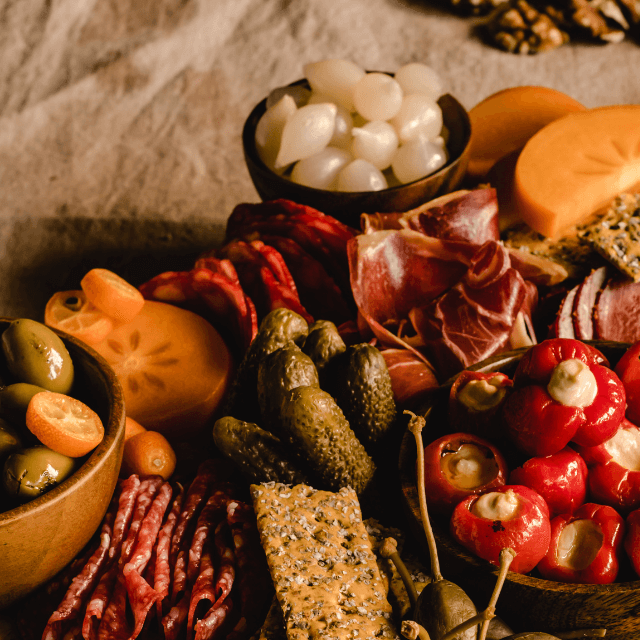
Popular Pairing Additions For Your Easy Charcuterie Board
Here is a list of fruits, vegetables, condiments, nuts, oils, and garnishes that you can consider for your charcuterie board:
Fruits
- Grapes
- Apples
- Pears
- Figs
- Melon (such as cantaloupe or honeydew)
- Berries (such as strawberries, raspberries, or blueberries)
- Dried fruits (such as raisins, apricots, or cranberries)
Vegetables
- Carrot sticks
- Cucumber slices
- Cherry tomatoes
- Olives (such as green or Kalamata)
- Pickles
- Roasted peppers
- Mushrooms
Condiments
- Mustard (such as Dijon or whole grain)
- Honey
- Fig jam
- Fruit preserves (such as raspberry or apricot)
- Olive tapenade
- Balsamic glaze
- Hummus or other dips/spreads
Nuts
- Almonds
- Walnuts
- Cashews
- Pistachios
- Pecans
- Mixed nuts
Oils
- Extra virgin olive oil
- Balsamic vinegar
- Truffle oil
- Infused oils (such as garlic or chili)
Garnish
- Fresh herbs (such as rosemary, thyme, or basil)
- Edible flowers (see list below)
- Citrus zest
- Crack black pepper
Jams and Preserves
- Fig jam
- Raspberry preserves
- Apricot butter
- Blueberry preserves
- Cranberry orange conserve
- Fig and honey conserve
- Strawberry jam
- Raspberry jelly
- Apple butter
- Chutney
- Peach jam
- Blackberry jam
Feel free to mix and match these ingredients based on your preferences and the flavors you want to offer on your charcuterie board. Enjoy!
Step 4: Arrange Your Easy Charcuterie Board
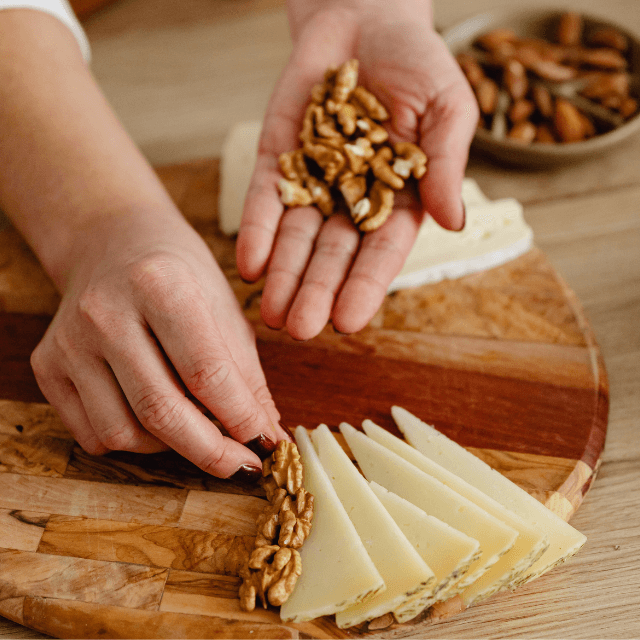
Add the cured meats, cheeses, bread or crackers, fruits or vegetables, condiments, and nuts on a serving board. Consider garnishing with fresh herbs or edible flowers for an extra touch.
Popular Charcuterie Board Garnish
Here are some herbs and edible flowers that you can consider adding to your charcuterie board:
Herbs
- Rosemary
- Thyme
- Basil
- Oregano
- Chives
- Cilantro
- Mint
- Sage
- Dill
- Parsley
Edible Flowers
- Pansies
- Calendula
- Lavender
- Rose petals
- Chamomile
- Marigold
- Chive blossoms
These herbs and edible flowers not only add a pop of color to your charcuterie board but also bring a fresh and aromatic element to the overall presentation.
Be extremely cautious when using edible flowers to ensure they are edible! Never scavenge for wildflowers without expert consultation.
Step 5: Serve And Enjoy Your Delicious And Wallet-Friendly Easy Charcuterie Board!
Remember, the key is to focus on affordable options that pair well and still provide a variety of flavors and textures. Enjoy!
Be cautious of allergies! These recommendations should always be based on your diet and preferences. If you have concerns about foods and food pairings please consult your doctor before eating.
The Ultimate Easy Charcuterie Board Pairings List
Here are some popular cheese, meat, bread, or crackers, and additional element pairings for your charcuterie board,
Here is a chart of pairings:
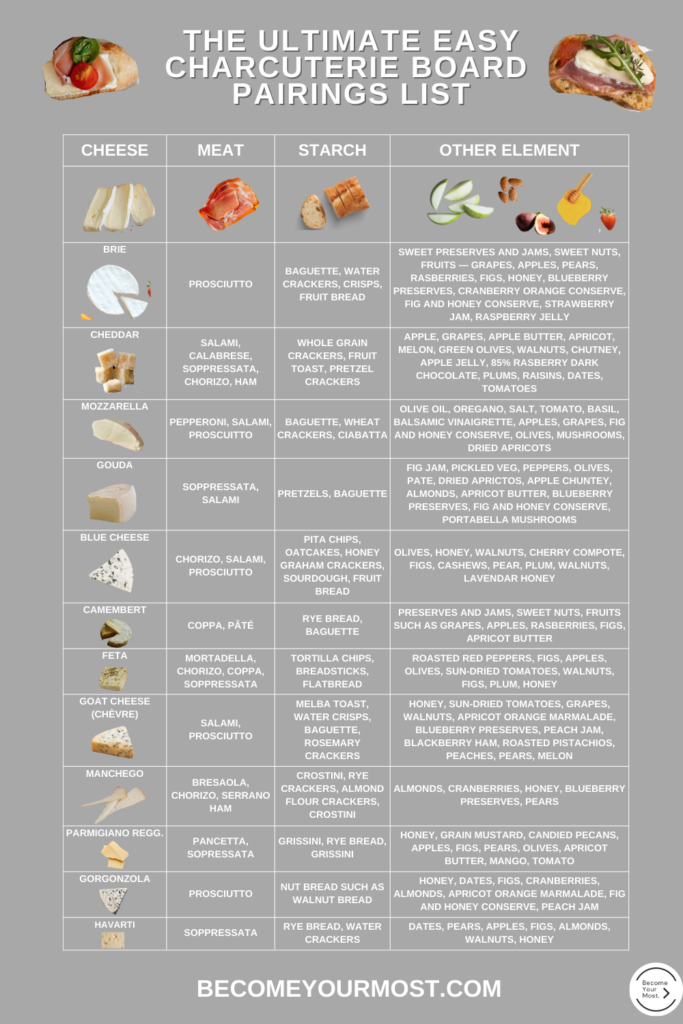
Feel free to get creative and experiment with different combinations based on your preferences. Enjoy your charcuterie board!
How Do You Arrange An Easy Charcuterie Board?
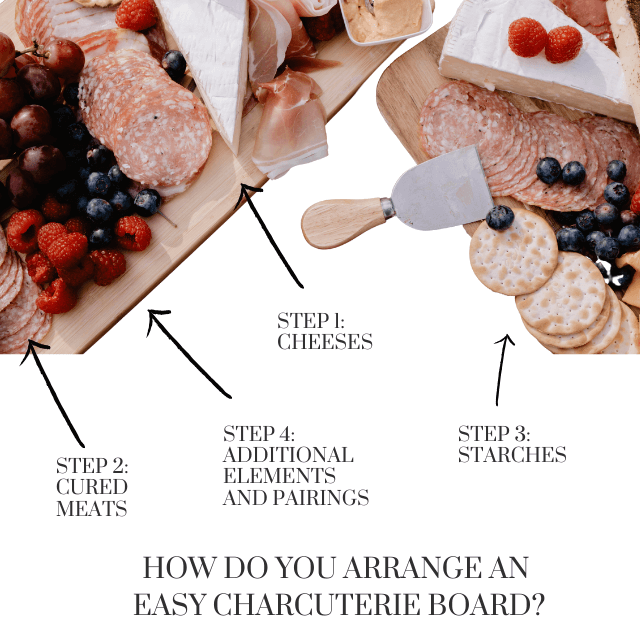
To arrange a simple charcuterie board, follow these steps:
- Start with a suitable serving board or platter. Choose one that is large enough to accommodate your selection of meats, cheeses, and accompaniments.
- Add the cheeses. Place them in different areas of the board, ensuring a variety of textures and flavors. You can cut them into bite-sized pieces or leave them whole for guests to slice.
- Next, add the starches. Place a selection of crackers, breadsticks, or bread slices on the board. These provide a base for enjoying the meats and cheeses.
- Enhance the board with fruits or vegetables. Add fresh grapes, apple slices, or carrot sticks for a refreshing and colorful touch. You can also include dried fruits like raisins or apricots for added variety.
- Consider adding condiments and spreads. Include small bowls or ramekins of mustard, honey, or fig jam for guests to enjoy with the meats and cheeses. These condiments add extra flavor to the board.
- Complete the arrangement with nuts. Add a handful of walnuts, almonds, or cashews to provide a crunchy element to the board.
- Optionally, garnish with fresh herbs. Sprinkle some fresh herbs like rosemary or thyme over the board for added aroma and presentation.
Remember, the key to arranging a simple charcuterie board is to create an appealing display with a variety of flavors and textures. Feel free to get creative and customize the board based on your preferences and the preferences of your guests. Enjoy!
Tips For Making An Easy Charcuterie Board?
Here are some fun tips for making a charcuterie board:
Get creative with shapes and arrangements. Use cookie cutters to cut cheese into fun shapes or arrange ingredients in a unique pattern.
Incorporate a variety of textures. Include crunchy nuts, creamy cheeses, and chewy dried fruits to add interest to your board.
Play with colors. Use a variety of colorful fruits, vegetables, and condiments to make your board visually appealing.
Experiment with different flavors. Include a mix of sweet, savory, and tangy ingredients to cater to different taste preferences.
Add unexpected elements. Surprise your guests with unique additions like pickled vegetables, flavored olives, or artisanal chocolates.
Include a theme. Create a themed charcuterie board based on a specific cuisine or occasion, such as Mediterranean or Halloween.
Other Fun Charcuterie Board Tips
Offer a variety of dips and spreads. Include a selection of flavored mustards, honey, or gourmet spreads for guests to enjoy.
Label your ingredients. Use mini chalkboards or small signs to identify the different components of your charcuterie board.
Have fun with the presentation. Use decorative serving utensils, unique serving boards, or elegant cheese knives to elevate the visual appeal of your board.
Watch this video to determine the best cheese knives for cutting your charcuterie cheeses.
Remember, the goal is to create a visually stunning and delicious charcuterie board that will impress your guests and spark conversation. Enjoy!
Easy Charcuterie Board Themes
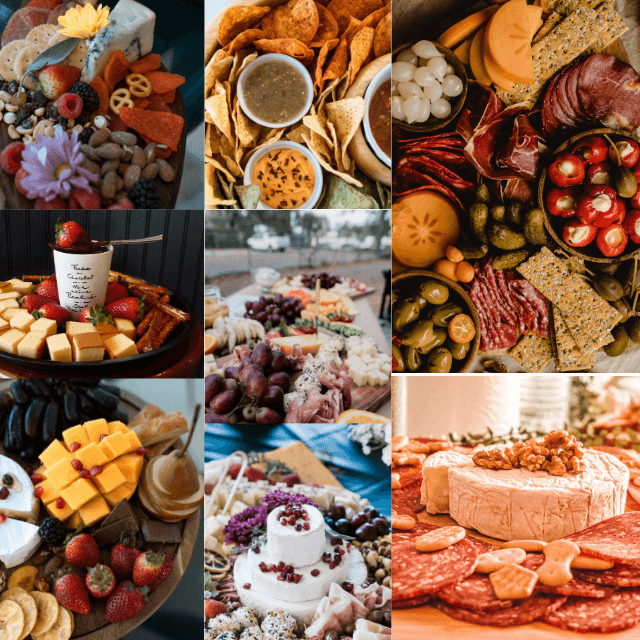
Here are some charcuterie board theme ideas to inspire your next gathering:
- Mediterranean Delights: Include an assortment of Mediterranean cheeses, such as feta and halloumi, along with olives, hummus, sun-dried tomatoes, and pita bread.
- Italian Feast: Feature Italian cured meats like prosciutto and soppressata, alongside a variety of Italian cheeses like Parmigiano Reggiano and mozzarella. Add marinated artichokes, bruschetta, and breadsticks to complete the theme.
- French Elegance: Create a board with French cheeses like Brie and Camembert, paired with baguette slices, pâté, cornichons, and Dijon mustard.
- Asian Fusion: Incorporate Asian-inspired flavors with sushi rolls, edamame, teriyaki-glazed chicken skewers, sesame crackers, and a variety of dipping sauces.
- Holiday Special: Design a charcuterie board themed around a specific holiday, such as Christmas or Thanksgiving, with festive cheeses, seasonal fruits, and holiday-themed crackers.
- Farmers Market Fresh: Highlight fresh and locally sourced ingredients with a combination of seasonal fruits, artisanal cheeses, homemade jams, and crusty bread.
- Sweet and Savory: Combine sweet and savory elements with a selection of cheeses, cured meats, fresh berries, honeycomb, chocolate, and candied nuts.
- Game Day Snacks: Create a sports-themed charcuterie board with mini sliders, chicken wings, pretzels, nachos, and a variety of dipping sauces.
- Brunch Bonanza: Build a charcuterie board filled with breakfast and brunch favorites like smoked salmon, cream cheese, bagels, fresh fruits, yogurt, granola, and pastries.
Feel free to customize these themes based on your preferences and the occasion. Enjoy exploring different flavor combinations and creating unique charcuterie boards for your gatherings!
Tips To Make Your Easy Charcuterie Board More Affordable
Here are some tips to make your charcuterie board more affordable:
- Choose budget-friendly ingredients: Opt for affordable cured meats like salami or pepperoni, and economical cheeses such as cheddar or mozzarella.
- Shop for seasonal produce: Include fruits and vegetables that are in season, as they tend to be more affordable and flavorful.
- Buy in bulk: Purchase crackers, breadsticks, or bread in bulk to save money. You can also consider buying larger portions of cheese or meats and portioning them out yourself.
- Look for sales and discounts: Keep an eye out for sales or discounts on cured meats, cheeses, and other ingredients. This can help you save money while still enjoying a variety of flavors.
- Use affordable condiments: Instead of expensive gourmet condiments, opt for simple and affordable options like mustard, honey, or homemade spreads.
- Consider homemade options: Make your own dips, spreads, or even bread to save money and add a personal touch to your charcuterie board.
- Use smaller serving portions: Instead of serving large quantities of each item, serve smaller portions. This allows you to offer a variety of options without breaking the bank.
- Get creative with presentation: Focus on arranging the ingredients in an appealing way to make your charcuterie board visually enticing. This can make a simple and affordable board look more impressive.
Remember, the key is to balance cost-effectiveness with variety and flavor. With these tips, you can create a delicious and budget-friendly charcuterie board that will impress your guests without breaking the bank. Enjoy!
What is The 3-3-3-3 Rule for Charcuterie Boards?
The 3-3-3-3 rule is simple:
Add 3 types of meat (such as salami, prosciutto, soppressata)
Include 3 kinds of cheese (such as brie, cheddar, manchego) + 3 starches (such as crackers, bread, breadsticks)
Add 3 additives (such as dips like bruschetta or fig preserves, fruit, and nuts)
The 3-3-3-3 rule can help you ensure a wide variety of types of flavors, textures, aromas, colors, and experiences.
This rule is perfect in case your crowd has a variety of preferences so they aren’t stuck with just one or two items they don’t like that then ruin all the pairings.
This post was all about creating an easy charcuterie board that is both delicious and wallet-friendly.
We explored the different components of a charcuterie board, including cheeses, cured meats, bread or crackers, fruits or vegetables, condiments, nuts, and garnishes. We provided pairing suggestions for each component and shared tips on how to arrange and present your charcuterie board.
Additionally, we discussed the 3-3-3-3 rule for creating a well-balanced board and provided insights into the origins and uses of charcuterie boards. Whether you’re hosting a party or simply looking for a delightful snack, a well-crafted charcuterie board is sure to impress your guests and satisfy your taste buds.
Enjoy the art of charcuterie and have fun exploring different flavor combinations!
Spa Bathroom Ideas – The Best Luxurious But Affordable Tips
This is the ultimate guide to spa bathroom ideas to make your bathroom look and…
Study Music For Better Focus | The Best Ambient Concentration Music
This is the ultimate guide to finding the best ambient music to help you study….
Valentine’s Day Gifts | Unique Ideas You Might Not Have Considered
This post is the top guide to finding amazing Valentine’s Day gifts that are affordable,…
Valentine’s Day Gifts For Him – The Best Gift Guide (Helpful)
This is the ultimate guide to finding the perfect Valentine’s Day gifts for him! No…
College Resume – How To Write The Best Resume (Template)
This guide is the best way to write a college resume that will help you…
Bridesmaid Box Ideas – The Best Creative Budget Ideas (Unique!)
🤍 These thought-provoking and creative bridesmaid box ideas are the best way to ask your…



























